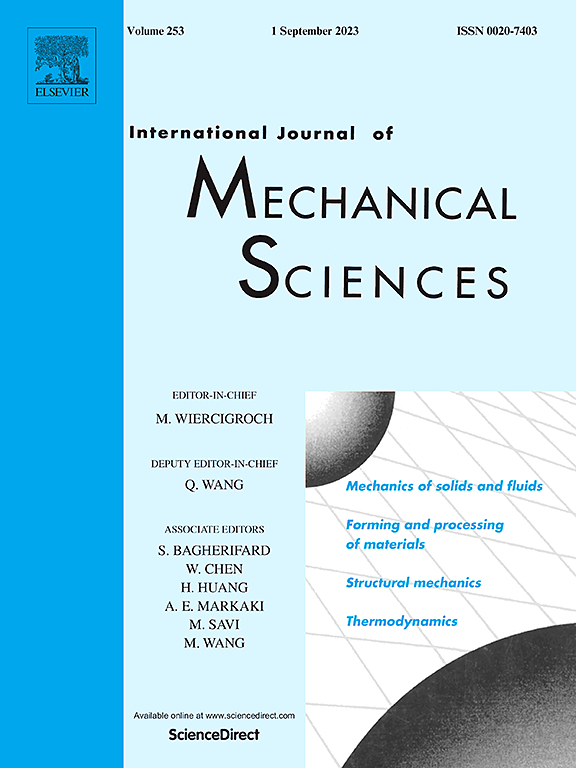Mode coupled vibration in distributed driven T-shaped MEMS resonant systems
IF 7.1
1区 工程技术
Q1 ENGINEERING, MECHANICAL
International Journal of Mechanical Sciences
Pub Date : 2025-02-01
DOI:10.1016/j.ijmecsci.2025.109983
引用次数: 0
Abstract
Mode coupled vibration plays an important role in improving the dynamic performance of MEMS resonators and broadening the application range of micro-resonant devices. However, the mode coupled vibration behavior depends heavily on the natural frequency and nonlinear stiffness of MEMS resonators. In this study, a distributed electrostatic driven T-shaped resonant structure with 1:2 internal resonance potential is designed and fabricated for the first time, which can realize the modulation of mode coupled vibration by introducing multiple electrodes. Firstly, the effects of distributed driving voltage on natural frequency and dynamic behavior are measured experimentally. When the control voltage is between 210 V and 225 V, the resonator may have obvious mode coupled vibration phenomenon. Through perturbation and bifurcation analysis, the physical conditions of mode coupled vibration are deduced theoretically. It is interesting to note that both stiffness hardening and stiffness softening occur in T-shaped resonators. The mode coupled vibration phenomenon occurs twice from forward and reverse frequency sweeps. Typically, the double mechanical frequency locking induced by the transfer of vibration energy from higher mode to lower mode is measured experimentally. As the AC driving voltage increases, the resonator has obvious peak frequency stability intervals, which greatly improves the robustness of the peak frequency. Besides, the influence of vacuum degree on the mode coupled vibration behavior is also measured experimentally and predicted theoretically. With the decrease of vacuum degree, the critical driving voltage of mode coupled vibration increases obviously, which provides a new idea for the detection of vacuum degree.

求助全文
约1分钟内获得全文
求助全文
来源期刊

International Journal of Mechanical Sciences
工程技术-工程:机械
CiteScore
12.80
自引率
17.80%
发文量
769
审稿时长
19 days
期刊介绍:
The International Journal of Mechanical Sciences (IJMS) serves as a global platform for the publication and dissemination of original research that contributes to a deeper scientific understanding of the fundamental disciplines within mechanical, civil, and material engineering.
The primary focus of IJMS is to showcase innovative and ground-breaking work that utilizes analytical and computational modeling techniques, such as Finite Element Method (FEM), Boundary Element Method (BEM), and mesh-free methods, among others. These modeling methods are applied to diverse fields including rigid-body mechanics (e.g., dynamics, vibration, stability), structural mechanics, metal forming, advanced materials (e.g., metals, composites, cellular, smart) behavior and applications, impact mechanics, strain localization, and other nonlinear effects (e.g., large deflections, plasticity, fracture).
Additionally, IJMS covers the realms of fluid mechanics (both external and internal flows), tribology, thermodynamics, and materials processing. These subjects collectively form the core of the journal's content.
In summary, IJMS provides a prestigious platform for researchers to present their original contributions, shedding light on analytical and computational modeling methods in various areas of mechanical engineering, as well as exploring the behavior and application of advanced materials, fluid mechanics, thermodynamics, and materials processing.
 求助内容:
求助内容: 应助结果提醒方式:
应助结果提醒方式:


